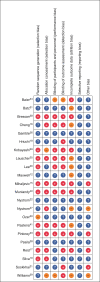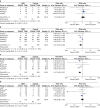The clinical effectiveness of wound edge protectors in reducing surgical site infection after abdominal surgery: meta-analysis
- PMID: 35543265
- PMCID: PMC9092446
- DOI: 10.1093/bjsopen/zrac065
The clinical effectiveness of wound edge protectors in reducing surgical site infection after abdominal surgery: meta-analysis
Abstract
Background: Surgical site infection (SSI) is a common complication after abdominal surgery. The effectiveness of wound edge protectors in reducing infection of the surgical sites is still unclear. The purpose of this study was to determine the clinical effectiveness of a wound edge protector (WEP) in reducing SSI rates after abdominal surgery.
Methods: PubMed, Embase, Web of Science, and the Cochrane Library were systematically searched to obtain relevant articles published up to September 2021. Publications were retrieved if they contain primary data on the use of WEPs in reducing SSI compared with standard care in patients undergoing abdominal surgery. Subgroup analyses were performed for different WEP types, surgical sites, and levels of contamination. The outcome of interest was a clinically defined SSI. Qualitative variables were pooled using risk ratios (RRs).
Results: Twenty-two eligible randomized clinical trials involving 4492 patients were included in this meta-analysis. WEP was associated with the reduced incidence of overall SSI (RR = 0.66; 95 per cent c.i. 0.53 to 0.83; P = 0.0003), and superficial SSI (RR = 0.59; 95 per cent c.i. 0.38 to 0.91; P = 0.02). In addition, WEP also successfully reduced the risk of SSI in clean-contaminated wounds (RR = 0.61; 95 per cent c.i. 0.40 to 0.93; P = 0.02) as well as in contaminated wounds (RR = 0.47; 95 per cent c.i. 0.33 to 0.67; P < 0.0001); however, WEP did not reduce SSI incidence in colorectal surgery (RR = 0.68; 95 per cent c.i. 0.46 to 1.01; P = 0.05).
Conclusion: This study suggests that WEP was efficient in reducing superficial SSI. Both double-ringed and single-ringed devices were efficient in reducing SSI. WEP was effective in reducing SSI incidence in clean-contaminated and contaminated surgery; however, its use does not reduce the SSI rate in colorectal surgery.
© The Author(s) 2022. Published by Oxford University Press on behalf of BJS Society Ltd.
Figures








Similar articles
-
The efficacy of wound edge protectors in reducing the post-operative surgical site infections after abdominal surgery: a meta-analysis of randomized clinical studies.Wideochir Inne Tech Maloinwazyjne. 2023 Dec;18(4):541-550. doi: 10.5114/wiitm.2023.132070. Epub 2023 Oct 12. Wideochir Inne Tech Maloinwazyjne. 2023. PMID: 38239586 Free PMC article.
-
Role of wound protectors in preventing surgical site infection in patients undergoing abdominal surgery: a meta-analysis of randomized controlled trials.BMC Surg. 2025 Feb 18;25(1):72. doi: 10.1186/s12893-025-02809-9. BMC Surg. 2025. PMID: 39966888 Free PMC article.
-
Effectiveness of Wound-Edge Protectors for Preventing Surgical Site Infections after Open Surgery for Colorectal Disease: A Prospective Cohort Study with Two Parallel Study Groups.Dig Surg. 2019;36(1):83-88. doi: 10.1159/000488214. Epub 2018 Apr 26. Dig Surg. 2019. PMID: 29698971 Clinical Trial.
-
Wound protectors reduce surgical site infection: a meta-analysis of randomized controlled trials.Ann Surg. 2012 Jul;256(1):53-9. doi: 10.1097/SLA.0b013e3182570372. Ann Surg. 2012. PMID: 22584694
-
Systematic review and meta-analysis of randomized controlled trials of the clinical effectiveness of impervious plastic wound protectors in reducing surgical site infections in patients undergoing abdominal surgery.Surgery. 2018 Nov;164(5):939-945. doi: 10.1016/j.surg.2018.05.024. Epub 2018 Aug 9. Surgery. 2018. PMID: 30098815
Cited by
-
Effect of wound protectors in reducing the incidence of surgical site wound infection in lower gastrointestinal surgery: A meta-analysis.Int Wound J. 2023 Mar;20(3):813-821. doi: 10.1111/iwj.13928. Epub 2022 Sep 18. Int Wound J. 2023. Retraction in: Int Wound J. 2025 Apr;22(4):e70465. doi: 10.1111/iwj.70465. PMID: 36117245 Free PMC article. Retracted.
-
Preparing the Bowel (Microbiome) for Surgery: Surgical Bioresilience.Clin Colon Rectal Surg. 2023 Feb 3;36(2):138-145. doi: 10.1055/s-0042-1760675. eCollection 2023 Mar. Clin Colon Rectal Surg. 2023. PMID: 36844712 Free PMC article. Review.
-
THE EFFECT OF SKIN ANTISEPSIS AFTER PRIMARY SKIN CLOSURE ON THE INCIDENCE OF SURGICAL SITE INFECTION AFTER ABDOMINAL SURGERY FOR SEPSIS: A PRELIMINARY REPORT OF A RANDOMISED CONTROLLED TRIAL.Ann Ib Postgrad Med. 2023 Dec;21(3):46-56. Epub 2024 Jan 30. Ann Ib Postgrad Med. 2023. PMID: 38706616 Free PMC article.
-
The efficacy of wound edge protectors in reducing the post-operative surgical site infections after abdominal surgery: a meta-analysis of randomized clinical studies.Wideochir Inne Tech Maloinwazyjne. 2023 Dec;18(4):541-550. doi: 10.5114/wiitm.2023.132070. Epub 2023 Oct 12. Wideochir Inne Tech Maloinwazyjne. 2023. PMID: 38239586 Free PMC article.
-
Role of wound protectors in preventing surgical site infection in patients undergoing abdominal surgery: a meta-analysis of randomized controlled trials.BMC Surg. 2025 Feb 18;25(1):72. doi: 10.1186/s12893-025-02809-9. BMC Surg. 2025. PMID: 39966888 Free PMC article.
References
-
- Horan TC, Gaynes RP, Martone WJ, Jarvis WR, Emori TG. CDC definitions of nosocomial surgical site infections 1992. A modification of CDC definitions of surgical wound infections. Infect Control Hosp Epidemiol 1992;13:606–608 - PubMed
-
- Horan TC, Andrus M, Dudeck MA. CDC/NHSN surveillance definition of health care–associated infection and criteria for specific types of infections in the acute care setting. Am J Infect Control 2008;36:309–332 - PubMed
-
- Barie PS, Wilson SE. Impact of evolving epidemiology on treatments for complicated skin and skin structure infections: the surgical perspective. J Am Coll Surg 2015;220:105–116.e6 - PubMed
-
- WHO . Global Guidelines for the Prevention of Surgical Site Infection. Geneva: World Health Organization, 2018 - PubMed
-
- Altemeier WA, Culbertson WR, Hummel RP. Surgical considerations of endogenous infections–sources, types, and methods of control. Surg Clin North Am 1968;48:227–240 - PubMed
Publication types
MeSH terms
LinkOut - more resources
Full Text Sources

